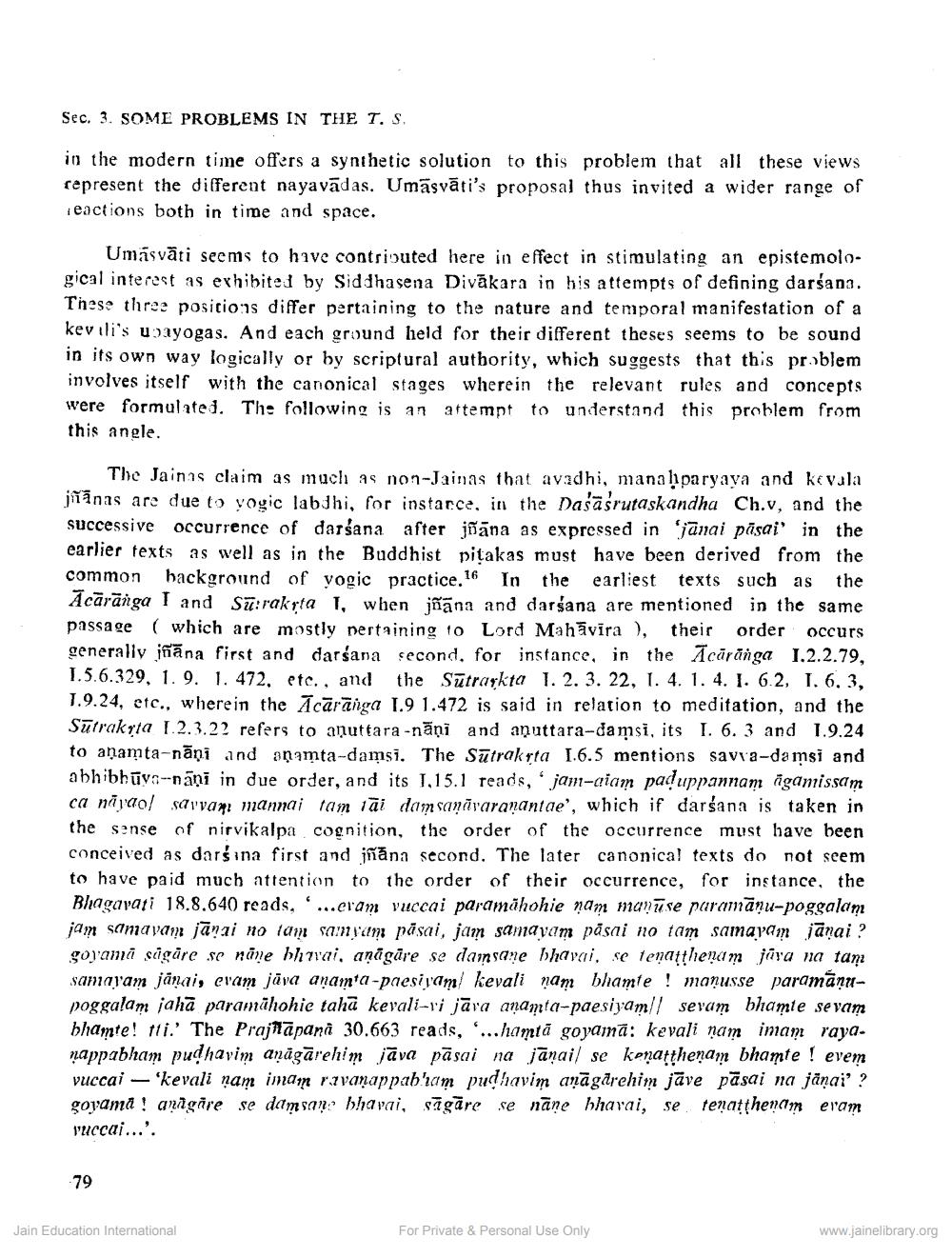________________
Sec. 3. SOME PROBLEMS IN THE T.S.
in the modern time offers a synthetic solution to this problem that all these views represent the different nayavādas. Umāsvāti's proposal thus invited a wider range of eactions both in time and space.
Umäsväti seems to have contributed here in effect in stimulating an epistemological interest as exhibited by Siddhasena Divākara in bis attempts of defining darsana. These three posicions differ pertaining to the nature and temporal manifestation of a kev ili's upayogas. And each ground held for their different theses seems to be sound in its own way logically or by scriptural authority, which suggests that this problem involves itself with the canonical stages wherein the relevant rules and concepts were formulated. The following is an attempt to understand this problem from this angle.
The Jainas claim as much as non-Jainas that avadhi, mana h paryava and kevala jirānas are due to yogic labdhi, for instarce, in the Dašāšrutaskandha Ch.v, and the successive occurrence of darśana after jñāna as expressed in jānai pāsai' in the earlier texts as well as in the Buddhist pitakas must have been derived from the common background of yogic practice. 16 In the earliest texts such as the Acaranga I and Surrakrta I, when jñana and darsana are mentioned in the same passage ( which are mostly nertaining to Lord Mahavira), their order occurs generally ifāna first and darśana second, for instance, in the Ācāränga 1.2.2.79, 1.5.6.329, 1. 9. 1. 472, etc., and the Sutrarkta 1. 2. 3. 22, 1. 4. 1. 4. I. 6.2, 1. 6. 3, 1.9.24, etc., wherein the Acārānga 1.9 1.472 is said in relation to meditation, and the Sutrakzia 1.2.3.2? refers to aņuttara-nāņi and aņuttara-damsi, its I. 6. 3 and 1.9.24 to anamta-nāni and anamta-damsi. The Sūtrakrta 1.6.5 mentions savva-damsi and a bhibhūva-nāni in due order, and its 1.15.1 reads, jam-aiam pad uppannam agamissam ca najao/ sauvam mannai tam 1āi dam sandvaranantae', which if darsana is taken in the sense of nirvikalpa cognition, the order of the occurrence must have been conceived as darsina first and jñāna second. The later canonical texts do not seem to have paid much attention to the order of their occurrence, for instance, the Bhagavati 18.8.640 reads,'...cram yuccai paramähohie nam manūse paramānu-poggalam jam samavam jānai no iam sanjam pasai, jam samayam pāsai no tam samayain jānai ? gojamā sagăre se nane bharai, anāgāre se dainsane bhavai, se tenattlienam java na tam samaram jānai, evam jāva anamta-presiyam kevali nam bhamte ! manusse paramánupoggalam jahā paramāhohie taha kevali-ri jāra anamta-paesiyam/l seram bhamte sevan bhante! 11: The Prajñāpanā 30.663 reads, ... hamtā goyama: kevali nam imam raya. nappabham pudhavim anāgārehim jāva pāsai na jānail se konatthenam bhamte ! evem vuccai — 'kevali nam imam ryvanappablıam pudhavim aņāgărehim jāve pasai na jänai'? goyama ! anagire se damsan. bhavai, sīgāre se nane bhavai, se tenatthenam eram luccai...'.
79
Jain Education International
For Private & Personal Use Only
www.jainelibrary.org




